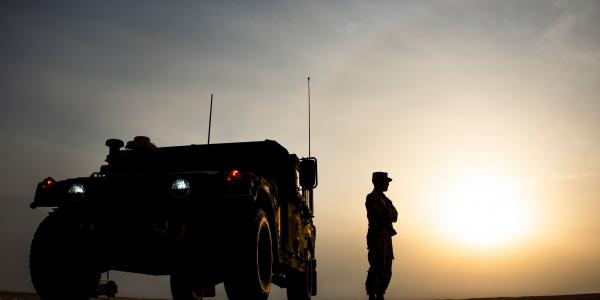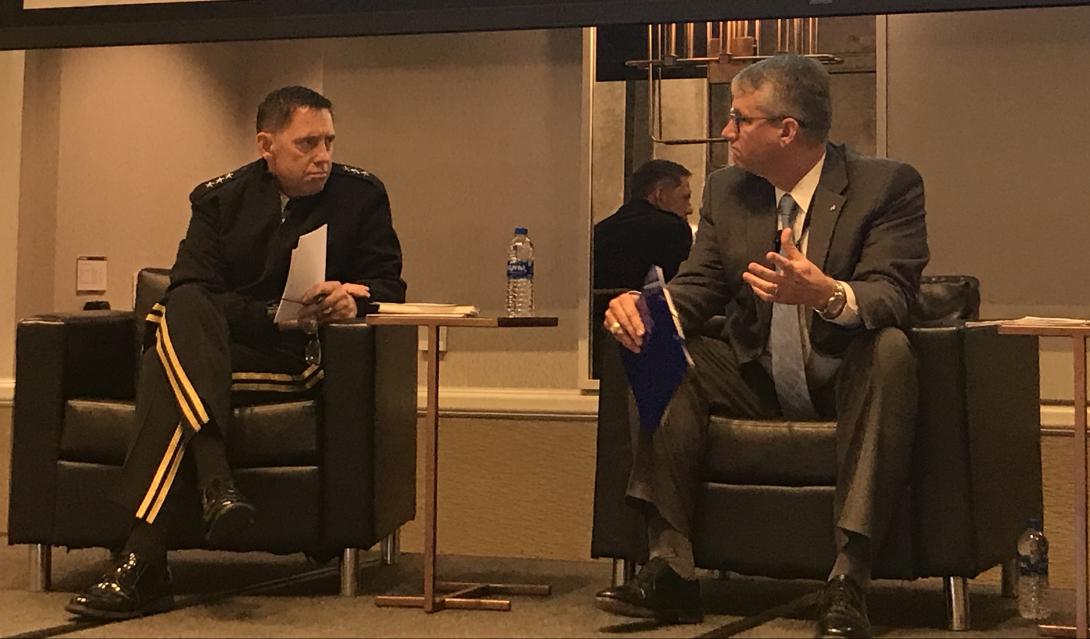The Army Shapes Joint All-Domain Operations
The message from the intelligence community and top leaders of the U.S. military is clear. The nation is in near-peer competition, just underneath the level of outright war. As such, the U.S. military is investing in aligning its capabilities and functionality to fight as a Joint force seamlessly across the sea, air, land, space and cyberspace. Along with the other services, the U.S. Army is working to shape the approach of how the military will fight in the future under Joint all-domain operations.
For the Army, it may mean a shift from solely a brigade combat team, or BCT, focus that worked well in a counterinsurgency environment, to a more flexible force structure above the brigade level that enables multidomain operations, says Lt. Gen. Eric Wesley, USA, director, Futures and Concepts Center (FCC), and deputy commanding general, U.S. Army Futures Command. The FCC is responsible for divining the Army’s future operating environment and then deriving the related operating concepts and informing doctrine. In supervising those activities, Gen. Wesley reports directly to Gen. John “Mike” Murray, commander, Army Futures Command.
“For the last 30 years, we have been the dominant preeminent force in the world, and we’ve had luxuries during that time that are now waning,” Gen. Wesley explains. “In the early 2000s, when we went to modularity, we became much more BCT-centric in our design methodology and BCTs in the COIN [counterinsurgency] environment were fully sufficient because they had sufficient power relative to the threats we were facing. But in doing that, we got rid of our capability to add echelon, and we lost to some degree the ability to conduct campaign-level operations across the theater.”
To address the gaps, the Army has set a goal of achieving multidomain operations by the year 2028. While it is a tall order, the service is making key strides to achieve this operational vision, the director contends. Led by the FCC, the process starts with designing the conceptual components of multidomain operations, which the Army released in December 2018, and then defining the practices that will guide warfighters across an all-domain battlefield. This would be the doctrine for multidomain operations, which the Army is in the process of creating, he states.
As part of that effort, the general’s team at the FCC is building the operations and organizations, known as ONOs, and is coordinating that development with the Combined Arms Center (CAC), which is led by Lt. Gen. James Rainey, USA, who also is the commander of Fort Leavenworth.
“We’re starting with those things that we have the capability to do and moving it into the doctrine so that we can start training at the right level for these capabilities of the future,” he explains. “We want to make sure what we are writing as doctrine is consistent with what is in multidomain operations, and that they are writing a doctrine that is within the realm of the possible. It’s a give and take, and it’s a process which takes a while, but by the end of this year you’re going to see some decisions on the rate at which we move concept into doctrine.”
However, an overarching component of that process is the Army’s contribution to how the entire U.S. military will engage across the air, sea, land, cyber and space warfighting domains, or Joint all-domain operations, also known as JADO.
“You just can’t have different services have their own MDO concepts and federate them together,” Gen. Wesley clarifies. “It’s the unique nature of MDO, integrating all the domains of warfare: space, cyber, electromagnetic warfare, land, maritime, and air. And it’s the integration of those things such that the total is greater than the sum of the parts that creates overmatch against your opponent. But because those domains all come from different services and in some cases are parts of the interagency, you quickly realize that this has to be a top-down effort.”
The military also is organizing the joint approach to command and control for that future operating environment, or the functional concept of joint all-domain command and control, known as JADC2. “And we have a key role in shaping and influencing the requirements and description of what that is,” he notes.
The Army is engaging with the Air Force, Space Force, Navy and the Marine Corps to develop the JADO concept by November and has been conducting exercises to test initial JADC2 functionality with the Air Force at its JADC2 center at Nellis Air Force Base, Nevada. So far, the general is optimistic regarding the progress towards JADO from a conceptual perspective.
“In the last year, we’ve gone from the services not communicating at all on a joint MDO concept, for all intents and purposes, to being months out from exercising a concept,” he states. “We are negotiating that with the other services to make it fit at the joint level. It is a joint effort and a joint design.”
Nonetheless, to achieve that level of convergence, “there is still a lot of work ahead to get that aligned,” the general suggests. The Air Force’s Advanced Battle Management System (ABMS), which the Air Force, Army and Navy first tested last December in a three-day exercise with the U.S. Northern Command, is a start, the general says, “but the next step is what’s under the hood. And what we aren’t clear on is how the Air Force systems connect with ours and how our systems connect with the Air Force, and that’s the hard work that has to be done. What we are advocating for is that it is incumbent on the Air Force’s ABMS system to connect to our capabilities, that it has got to be designed to enable our capabilities, because it is at the edge where these capabilities must bring their effects.”
In addition to the challenge of bringing the services together on a collective technical understanding of what must be built for JADC2, the services also need the technology required to conduct multidomain operations, Gen. Wesley ventures. Here, the Army’s communication, computing and tactical network capabilities will be crucial to achieving all-domain operations, the general continues. “To create overmatch, you have to be able to continually and rapidly integrate domains in the theater of war, not just at one point but across the theater,” he states. “That means you’re trying to integrate the air, cyber, space, land and maritime for effect rapidly and continuously, within minutes or seconds. The network becomes the backbone of your ability to conduct convergence, and your ability to integrate these domains will be dependent on the vitality of our network. That is where you will truly converge effects at the tempo we will have to have in the future.”
In the meantime, the Army’s Project Convergence—which features a technology demonstration still planned despite the pandemic for late August at the Globally Integrated Wargame—will test the design of the integrated sensors at the edge, and how information and data on targets moves to shooters. The project is led by Gen. Murray and Lt. Gen. James Richardson, USA, deputy commanding general for combat development. It is where the multidomain operations concept will prove itself out or not, Gen. Wesley says. “We’re going to demonstrate the first capabilities that the cross-functional teams are then going to manifest,” the director states.
Gen. Wesley also is working with the Combat Capabilities Development Command (CCDC), led by Maj. Gen. John George, USA, to coordinate technology developments in relation to Joint all-domain operational concepts. “There’s this symbiotic relationship between the FCC and CCDC, where the labs support the requirements that we say we will need, and inform us of the technologies that will come,” Gen. Wesley notes. Additionally, the director is interacting with Assistant Secretary of the Army for Acquisition Logistics and Technology Bruce Jette to consider how and when to purchase multidomain solutions for Joint warfighting “that are supported by what the labs say is available in terms of technology.”
Also, the FCC is taking the first steps in developing a related multidomain operations force structure for the Army through its AimPoint Force Structure Initiative. The center is examining what a flexible force structure template could look at the higher echelons above the brigade level—division, corps, field armies and theater armies—to evolve them from mere headquarters to interdependent, echeloned multidomain warfighting formations.
“We had to say, ‘What does the Army look like in order to develop what we call multidomain formations,’” the general says. “That’s AimPoint. AimPoint is a template that the chief of staff of the Army has approved for planning, and to be clear, all it is, is an azimuth or an orientation. It kind of describes in a template format what the Army ought to look like in order to be able to fight multidomain operations. It’s not a force structure design or what the size of the Army is or what the specific formations look like. It’s a template to experiment with and to plan against.”
As part of the AimPoint effort, the FCC is considering total Army analysis decisions, known as TAAs, to start building the structures that are defined by the template. “Those will be incremental, and when the chief can afford it, we’ll make decisions on those,” Gen. Wesley clarifies.
At each echelon, the Army would have to provide the ability to plug into the domain capabilities. “We don’t have the theater fires capability that we used to have, and we have lost the core fires capability and the division fires capability,” the director emphasizes. “In terms of campaigning, that skill set was mortgaged in order to enable us to conduct COIN operations at the BCT level. So, what AimPoint does is it describes our ability to fight at echelon. Also, if you are going to integrate all domains that cross all services and reach into the interagency, and you have to be able to integrate those very rapidly and continuously, you can see that you’ll need to have echelon responsibilities to integrate some of those capabilities for the right effect. So, it’s restoring a campaign-level quality Army to be able to fight in the future.”
The service chief has already signed off on developing a Theater Fires Command to integrate the fires across the theater, and he is building multidomain task forces intended to enable theater operational commanders to penetrate any adversarial anti-access/area denial, or A2AD, capabilities.
Over the next few months, the general’s main focus remains helping to finalize the JADO concept. “The joint concept, from an FCC perspective, is my number one priority,” Gen. Wesley states. “We’ve got to get that understood because that is going to define how the Joint Force fights. The Army thinks we know how we’re going to fight in the future, but we’ve got to get consensus across the Joint Force.”






Comments